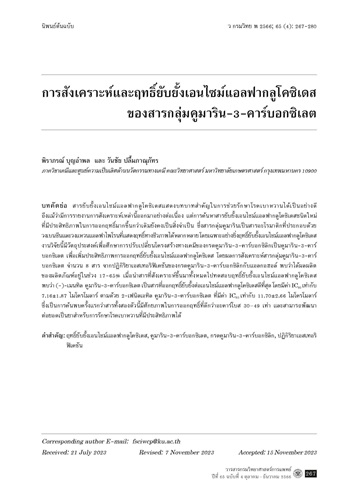Synthesis and α-Glucosidase Inhibitory Activity of Coumarin-3-Carboxylates
α-Glucosidase Inhibitory Activity of Coumarin-3-Carboxylates
Keywords:
α-Glucosidase inhibitory activity, Coumarin-3-carboxylates, Coumarin-3-carboxylic acid, EsterificationAbstract
α-Glucosidase inhibitors represent an important role in the treatment of diabetes. Although many synthetic inhibitors have been reported, novel and more efficient compounds are still necessary to exhibit this activity. Coumarins are aromatic substances composed of fused benzene and α-pyrone rings and display a wide variety of biological activities, especially α-glucosidase inhibitory activity. This research aimed to study the structural modification of coumarin-3-carboxylic acid into coumarin-3-carboxylates to enhance their α-glucosidase inhibitory activity. Eight coumarin-3-carboxylates were successfully synthesized by esterification using coumarin-3-carboxylic acid and alcohols as starting materials. The desired products were obtained in 17−65% yields. All synthesized compounds were examined for their α-glucosidase inhibitory activity. The results found that (-)-menthyl coumarin-3-carboxylate was the most potent inhibitor against α-glucosidase with an IC50 of 7.16±1.87 μM, followed by 2-phenylethyl coumarin-3-carboxylate with an IC50 of 11.70±2.66 μM. Both compounds were first reported to exhibit 30-49 folds activity more efficiently than acarbose and could be further developed into a new potential antidiabetic drug.
References
Gupta R, Gigras P, Mohapatra H, Goswami VK, Chauhan B. Microbial α-amylases: a biotechnological perspective. Process Biochem 2003; 38(11): 1599-616.
Yin Z, Zhang W, Feng F, Zhang Y, Kang W. α-Glucosidase inhibitors isolated from medicinal plants. Food Sci Hum Wellness 2014; 3(3-4): 136-74.
Zou J, Liu Y, Guo R, Tang Y, Shi Z, Zhang M, et al. An in vitro coumarin-antibiotic combination treatment of Pseudomonas aeruginosa biofilms. Nat Prod Commun 2021; 16(1): 1-7.
Lee BC, Lee SY, Lee HJ, Sim GS, Kim JH, Kim JH, et al. Anti-oxidative and photo-protective effects of coumarins isolated from Fraxinus chinensis. Arch Pharm Res 2007; 30(10): 1293-301.
Emami S, Dadashpour S. Current developments of coumarin-based anti-cancer agents in medicinal chemistry. Eur J Med Chem 2015; 102: 611-30.
de Souza LG, Rennã MN, Figueroa-Villar JD. Coumarins as cholinesterase inhibitors: a review. Chem Biol Interact 2016; 254: 11-23.
Kotthireddy K, Pasula A. Comprehensive review on the applications of coumarin fused with five membered heterocyclics in the field of material chemistry, agrochemistry and pharmacology. Res J Life Sci Bioinform Pharm Chem Sci 2018; 4(2): 203-24.
Fylaktakidou KC, Hadjipavlou-Litina DJ, Litinas KE, Nicolaides DN. Natural and synthetic coumarin derivatives with anti-inflammatory/antioxidant activities. Curr Pharm Des 2004; 10(30): 3813-33.
Qian H, Sun J. Synthesis of coumarins via [4+2] cyclization of siloxy alkynes and salicylaldehydes. Synlett 2021; 32: 207-10.
Luchini AC, Rodrigues-Orsi P, Cestari SH, Seito LN, Witaicenis A, Pellizzon CH, et al. Intestinal anti-inflammatory activity of coumarin and 4-hydroxycoumarin in the trinitrobenzenesulphonic acid model of rat colitis. Biol Pharm Bull 2008; 31(7): 1343-50.
Kahveci B, Yılmaz F, Menteşe E, Ülker S. Microwave-assisted synthesis of some new coumarin derivatives including 1,2,4-triazol-3-one and investigation of their biological activities. Chem Heterocycl Compd 2015; 51(5): 447-56.
Sun C, Peng C, Wang J, Wang Q, Liu W, Zhou H, et al. Synthesis of novel coumarin derivatives and in vitro biological evaluation as potential PTP 1B inhibitors. Heterocycles 2013; 87(8): 1711-26.
Yu X, Teng P, Zhang YL, Xu ZJ, Zhang MZ, Zhang WH. Design, synthesis and antifungal activity evaluation of coumarin-3-carboxamide derivatives. Fitoterapia 2018; 127: 387-95.
Ranđelović S, Bipat R. A review of coumarins and coumarin-related compounds for their potential antidiabetic effect. Clin Med Insights: Endocrinol Diabetes 2021; 14: 1-9.
Adib M, Peytam F, Rahmanian-Jazi M, Mohammadi-Khanaposhtanib M, Mahernia S, Bijanzadeh HR, et al. Design, synthesis, in vitro α-glucosidase inhibition, molecular modeling, and kinetic study of novel coumarin fused pyridine derivatives as potent antidiabetic agents. New J Chem 2018; 42: 17268-78.
Bhatia A, Singh B, Arora R, Arora S. In vitro evaluation of the α-glucosidase inhibitory potential of methanolic extracts of traditionally used antidiabetic plants. BMC Complement Altern Med 2019; 19: 74. (9 pages).
Devaraj S, Yip YM, Panda P, Ong LL, Wong PWK, Zhang D, et al. Cinnamoyl sucrose esters as alpha glucosidase inhibitors for the treatment of diabetes. Molecules 2021; 26(2): 469. (12 pages).
Kuang Y, Liu X, Chang L, Wang M, Lin L, Feng X. Catalytic asymmetric conjugate allylation of coumarins. Org Lett 2011; 13(15): 3814-7.
Singh S, Tripathi KN, Singh RP. Redox activated amines in the organophotoinduced alkylation of coumarins. Org Biomol Chem 2022; 20(29): 5716-20.
Ichikawa A, Ono H, Harada N. Stereochemical studies of chiral resolving agents, M9PP and H9PP acids. Chirality 2004; 16(8): 559-67.
Fischer E, Speier A. Darstellung der Ester. Ber Dtsch Chem Ges 1895; 28(3): 3252-8.
Tharamak S, Yooboon T, Pengsook A, Ratwatthananon A, Kumrungsee N, Bullangpoti V, et al. Synthesis of thymyl esters and their insecticidal activity against Spodoptera litura (Lepidoptera: Noctuidae). Pest Manag Sci 2020; 76(3): 928-35.
Chaysripongkul S, Pluempanupat W, Jang DO, Chavasiri W. Application of Cl3CCONH2/PPh3 towards the synthesis of bioactive amides. Bull Korean Chem Soc 2009; 30(9): 2066-70.
Zhang X, Zheng YY, Hu CM, Wu XZ, Lin J, Xiong Z, et al. Synthesis and biological evaluation of coumarin derivatives containing oxime ester as α-glucosidase inhibitors. Arab J Chem 2022; 15(9): 104072. (11 pages).
Zhao DG, Zhou AY, Du Z, Zhang Y, Zhang K, Ma YY. Coumarins with α-glucosidase and α-amylase inhibitory activities from the flower of Edgeworthia gardneri. Fitoterapia 2015; 107: 122-7.
Peytam F, Takalloobanafshi G, Saadattalab T, Norouzbahari M, Emamgholipour Z, Moghimi S, et al. Design, synthesis, molecular docking, and in vitro α-glucosidase inhibitory activities of novel 3-amino-2,4-diarylbenzo [4,5] imidazo [1,2-a] pyrimidines against yeast and rat α-glucosidase. Sci Rep 2021; 11: 11911. (18 pages).
Azizian H, Pedrood K, Moazzam A, Valizadeh Y, Khavaninzadeh K, Zamani A, et at. Docking study, molecular dynamic, synthesis, anti-α-glucosidase assessment, and ADMET prediction of new benzimidazole-Schiff base derivatives. Sci Rep 2022; 12: 14870. (12 pages).

Downloads
Published
How to Cite
Issue
Section
License
Copyright (c) 2023 BULLETIN OF THE DEPARTMENT OF MEDICAL SCIENCES

This work is licensed under a Creative Commons Attribution-NonCommercial-NoDerivatives 4.0 International License.



